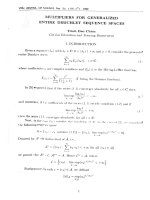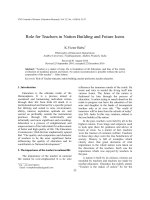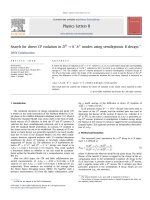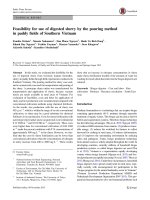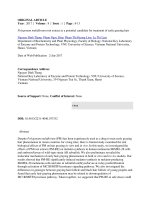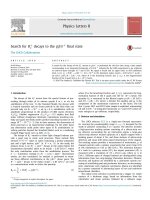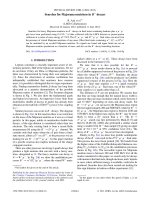DSpace at VNU: L-P-spaces for C -algebras with a state
Bạn đang xem bản rút gọn của tài liệu. Xem và tải ngay bản đầy đủ của tài liệu tại đây (49.97 KB, 7 trang )
International Journal of Theoretical Physics, Vol. 39, No. 3, 2000
Lp-Spaces for C*-Algebras with a State†
Stanisław Goldstein1 and Phan Viet Thu2
Received December 8, 1999
We present here a construction of noncommutative Lp-spaces for a C*-algebra
with respect to a state on the algebra. Their properties are deduced from wellestablished properties of corresponding Haagerup and Kosaki spaces. Two
examples are considered.
1. INTRODUCTION
There have been several attempts at the construction of noncommutative
Lp-spaces for specific C*-algebras (Majewski and Zegarlin´ski, 1995, 1996;
Goldstein and Phan, 1998). We give here a general definition and the basic
properties of the spaces. Further details may be found in Phan (1999).
Let M be a von Neumann algebra acting in a Hilbert space H and a
normal faithful semifinite weight on M. Let {t}t ޒdenote the modular
automorphism group on M associated with . Recall that the crossed product
ލϭ M ϫԽt ޒis a von Neumann algebra acting on ވϭ L2(ޒ, H ) generated
by operators M(a), a M and M(s), s ޒ, defined by
(M(a))(t) ϭ Ϫt
(a)(t) (M(s))(t) ϭ (t Ϫ s) ވ, t ޒ.
˜ the algebra of all
Let denote the canonical trace on ލ. Denote by ލ
-measurable operators affliated with ލ. The dual representation (or the dual
action of ޒon M ϫԽ )ޒis the continuous automorphism representation
s ۋs of ޒwhere s is the *automorphism of M ϫԽ ޒthat is implemented
by the unitary operator s defined by (s)(t) ϭ eϪits(t), L2 (ޒ, H ), t
ޒ. For each p [1, ϱ], the Haagerup Lp-space is defined by
†
This paper is dedicated to the memory of Prof. Gottfried T. Ru¨ttimann.
Faculty of Mathematics, University of Ło´dz´, Ło´dz´, Poland. E-mail address:
2
Faculty of Mathematics, Mechanics and Computer Science, Hanoi National University,
Hanoi, Vietnam.
1
687
0020-7748/00/0300-0687$18.00/0 ᭧ 2000 Plenum Publishing Corporation
688
Goldstein and Thu
˜ : ∀s ޒ, sh ϭ eϪs/p h}.
Lp (M ) :ϭ {h ލ
We identify Lϱ (M ) with M by means of M.
Lemma 1.1. Let M be a von Neumann algebra, a faithful normal state
on M, t the modular automorphism group of M associated with , ލϭ
M ϫԽ ޒ, the dual weight, the canonical normal faithful semifinite trace
on ލ, h ϭ d/d. Then, for p [1, ϱ],
the mapping ip M → Lp (M ) defined by a ۋip(a) ϭ h1/2p
и a и
is linear and injective;
h1/2p
и M0 и h1/2p
is
2. if M0 is -weakly dense in M, then ip(M0) ϭ h1/2p
p
norm-dense in L (M ) for p Ͻ ϱ (-weakly dense for p ϭ ϱ).
3. We have
1.
1 Յ r Յ p Յ ϱ ⇒ ሻir(x)ሻr Յ ሻip(x)ሻp ,
x M.
The first part can be found, for example, in Goldstein and Lindsay,
1995. As for the second part of the lemma, it is easy to prove for p ϭ 1
using duality. The proof for any p [1, ϱ] can be deduced from the Kaplansky
density theorem and the inequality
1/q
ሻh1/2p и a и h1/2p ሻp Յ ሻh1/2 и a и h1/2ሻ1/p
1 ሻaሻϱ
with 1/p ϩ 1/q ϭ 1, to be found in Terp (1982) or Goldstein and Lindsay,
1999. The last part follows from Ho¨lder’s inequality since
ir(x) ϭ h1/2s ip(x)h1/2s
where s [1, ϱ] satisfies 1/p ϩ 1/s ϭ 1/r.
2. DEFINITION OF Lp(A, ) SPACES.
Let A be a C*-algebra and a state on A; let (H, , ) denote the
GNS representation of A associated with . In this section we introduce the
spaces Lp(A, ). Their properties will be given in the next section. First let
us specify some notations that we shall use in the sequel.
1. is the vector state on (ނH) given by
(a) ϭ (a, ), a (ނH)
2. s is the support of the state Ȋ(A)Љ on the von Neumann algebra (A)Љ.
3. H denotes the Hilbert space sH (with the inner product inherited
from H).
4. M is the von Neumann algebra s(A)Љs acting on H.
Lp-Spaces for C*-Algebras With a State
689
5. denotes the faithful normal state ȊM.
6. t is the modular automorphism group of M relative to .
7. ލis the crossed product M ϫԽ t ޒacting on the Hilbert space ވ
2
ϭ L (ޒ, H ); the image M(M ) of M in ލwill be denoted by M, too
˜ - the
8. s denotes the dual action of ޒon ލor its extension to ލ
topological *algebra of -measurable operators affiliated with ލ.
9. is the canonical normal faithful semifinite trace on ލ.
10. Lp(M ) with p [1, ϱ] is the Haagerup space (consisting of measurable operators affiliated with )ލwith norm ሻ и ሻp.
11. h is the measurable operator affiliated with ލdefined by h ϭ
d/d, where is the dual weight of .
Consider the map ␥: A → M given by
a ۋs(a)s.
This is a positive linear contraction with -weakly dense range. Let N be
the kernel of ␥ and let ␥˜ denote the induced map A/N → M. Then N is
a closed involutive subspace of A, and the quotient space A/N is a Banach
space in the quotient norm, with positive elements of the form [a], for a
A+. The injective linear map ␥p :ϭ ip ˜␥ ؠ: A/N → Lp(M ) is positivity
preserving, and Lemma 1.1 implies that it has norm-dense range for p Ͻ ϱ
and -weakly dense range for p ϭ ϱ.
Norms are defined on A/N by
ሻ[a]ሻp ϭ ሻip(␥(a))ሻLp(M),
the resulting normed space is denoted Lp0(A, ). Thus, for p Ͻ ϱ, (Lp(M ),
␥p) is a completion of Lp0(A, ) in which the dense isometric embedding ␥p
respects positivity.
In order to obtain compatible spaces we consider a different family of
completions. Let (L1(A, ), ) be any completion of L10(A, ). By Lemma
2.1, the norms on A/N satisfy
ሻ[a]ሻr Յ ሻ[a]ሻp for 1 Յ r Յ p Յ ϱ.
Therefore completions (Lp(A, ), p) of Lp0(A, ) may be found satisfying
(A/N) ʚ Lp(A, ) ʚ Lr(A, ) ʚ L1(A, )
for 1 Յ r Յ p Ͻ ϱ.
The positive elements of Lp(A, ), p Ͻ ϱ, are given by
Lpϩ (A, ) ϭ closure in Lp(A, ) of p((A/N)+)
We denote by ⌫p the unique isometric isomorphism from Lp(A, ) to
L (M ) extending the maps ␥˜ and ␥p. It is clearly positivity preserving.
p
690
Goldstein and Thu
ϱ
Note that the mappings ⌫Ϫ1
p ؠip , p Ͻ ϱ, do not depend on p. Define L
(A, ) to be the image of M under the mappings. When restricted to Lϱ
ϱ
(A, ), the mapping iϪ1
p ⌫ ؠp is an isometric isomorphism from L (A, ) to
ϱ
L (M ) which extends ␥˜ and ␥ϱ. We denote it by ⌫ϱ.
It follows that the Lp-spaces over a C*-algebra with respect to a state
inherit all the standard properties of duality, reflexivity and uniform convexity,
and the Ho¨lder and Clarkson inequalities, from the Haagerup Lp-spaces. Note
also that Lϱ(A, ) and L1(A, ) form a compatible pair of Banach spaces. In
the next section we shall fix the multiplicative structure of the spaces and
state some of the properties that relate to the structure. We shall also show
that these Lp-spaces are complex interpolation spaces, by relating them to
Kosaki’s Lp-spaces.
3. THE PROPERTIES OF Lp(A, ) SPACES
Let p, q, r [1, ϱ] be such that 1/p ϩ 1/q ϭ 1/r. For a Lp(A, ),
b Lq(A, ) define a pиq b Lr(A, ) by
a pиq b :ϭ ⌫Ϫ1
r (⌫p(a) и ⌫q(b)).
Proposition 3.1 (Ho¨lder’s inequality). Let r, p, q [1, ϱ] be such that
1/p ϩ 1/q ϭ 1/r, a Lp(A, ), b Lq(A, ). Then
ሻa pиq bሻr Յ ሻaሻpሻbሻq.
•
We define a linear functional tr on L1(A, ) by
•
tr(a) ϭ tr(␥1(a)), a L1(A, ),
where tr is the usual linear functional tr on L1(M ). For p, q [1, ϱ], 1/p ϩ
1/q ϭ 1, a, b A/N define
•
͗aȊb͘ :ϭ tr(a pиq b).
Proposition 3.2. Let p, q [1, ϱ], 1/p ϩ 1/q ϭ 1. It follows that
1.
2.
3.
•
•
tr(a pиq b) ϭ tr(b qиp a);
͗aȊb͘ is independent of p, q [1, ϱ] such that 1/p ϩ 1/q ϭ 1;
͗иȊи͘ is bilinear.
Proposition 3.3. Suppose that p, q [1, ϱ], 1/p ϩ 1/q ϭ 1 and a
Lp(A, ); then
•
ሻaሻp ϭ sup{Ȋtr(a pиq b)Ȋ: b Lq(A, ), ሻbሻq Յ 1}.
Proposition 3.4. Let p ]1, ϱ] and 1/p ϩ 1/q ϭ 1.
Lp-Spaces for C*-Algebras With a State
1.
691
Let a Lp(A, ); then a defined by
•
a(b) :ϭ tr(a pиq b), b Lq(A, ),
2.
is a bounded linear functional on Lq(A, ).
The mapping a ۋa is an isometric isomorphism of Lp(A, ) onto
the dual Banach space of Lq(A, ).
Proposition 3.5. (L2(A, ), ሻ и ሻ2) is a Hilbert space with the inner product
•
•
(aȊb)L2(A,) :ϭ tr(b* 2и2 a)(ϭ tr(a 2и2 b*))
for a, b L2(A, ).
We turn now to interpolation. Let Lp(M ) denote the Kosaki spaces
defined by
Lp (M ) ϭ h1/2q
и Lp (M ) и h1/2q
ʚ L1 (M ), p, q [1, ϱ], 1/p ϩ 1/q ϭ 1,
with the norm
p
ሻh1/2q
и x и h1/2q
ሻp ϭ ሻxሻp for x L (M ).
We know that
Lϱ (A, ) ʚ Lp (A, ) ʚ Lq (A, ) ʚ L1 (A, )
for q [1, ϱ], q Յ p and that Lϱ (A, ) and L1 (A, ) form a pair of
compatible Banach spaces. Denote by C(X0, X1) the Calderon’s complex
interpolation functor for the pair of compatible Banach spaces (X0, X1) (Berg
and Lo¨fstro¨m, 1976; Calderon, 1964; Kosaki, 1984). We refer now to the
paper of Kosaki, 1984. Using his notation from sections 8, 9, we put 0 ϭ
0 ϭ , h0 ϭ k0 ϭ h and ϭ 1/2 where , h are our normal faithful
state on M and the corresponding Radon-Nikodym derivative defined at the
beginning of this section. We consider now the isometry
1/2
⌫1 : L1 (A, ) → L1 (M ), ⌫1ȊA/N : a ۋh1/2
и ⌫ϱ (a) и h .
Then the restriction of ⌫1 to Lp(A, ) is an embedding of Lp(A, ) into
the Haagerup L1(M ) space such that ⌫1(Lp(A, )) is exactly the Kosaki
complex interpolation space C1/p(M1/2, M*). In fact, it is clear that ⌫1 is an
isometric isomorphisms from L1(A, ) to L1(M ). We have
ϱ
1/2
⌫1(Lϱ(A, )) ϭ h1/2
и ⌫ϱ(L (A, )) и h
ϭ i1(Lϱ(M )) ϭ Lϱ(M ).
We easily check that ⌫1 restricted to Lϱ(A, ) takes the space isometrically
692
Goldstein and Thu
onto Lϱ(M ). For p ]1, ϱ[, let q ]1, ϱ[ be s.t. 1/p ϩ 1/q ϭ 1; then, for a
A/N,
и ␥p (a) и h1/2q
␥1 (a) ϭ h1/2q
.
Thus
⌫1 (Lp(A, )) ϭ h1/2q
и Lp(M ) и h1/2q
ϭ Lp(M ).
It is routine to check that ⌫p is an isometric isomorphism from Lp(A, ) to
Lp(M ). We conclude the following.
Theorem 3.6. C1/p(L1(A, ), Lϱ(A, )) ϭ Lp(A, ), that is our Lp-spaces
are interpolation spaces.
4. EXAMPLES
In view of possible applications (Majewski and Zegarlin´ski, 1995, 1996),
it is important to know how the Lp-spaces behave under inductive limits. We
exhibit two situations in which they behave well.
Theorem 4.1. Let (A, ␣t) be a C*-dynamical system and {Aj}jI a generating nest of C*-subalgebras of A, invariant under {␣t}. Let be an ␣t-KMS
state on A. Then, for p [1, ϱ[, Lp(A, ) is an inductive limit of {Lp(Aj ,
j)}jI where j ϭ ȊAj , j I and, moreover, Lp(A, ) Х Lp((A)Љ).
Theorem 4.2. Let A be a UHF C*-algebra with a generating nest {An}
and a product state on A with respect to the sequence {An}. Suppose that
for each i, i is faithful. Then for p [1, ϱ], Lp(A, ) is the inductive limit
of {Lp (An , (n))}; moreover, Lp (A, ) Х Lp ( (A)Љ).
ACKNOWLEDGEMENT
Full credit for the improvements in this revised version of the paper
goes to J. Martin Lindsay. The first named author was supported by KBN
grant 2P03A 044 10.
REFERENCES
Berg, J. and Lo¨fstro¨m J. (1976) Interpolation spaces: An introduction, Springer Verlag, Berlin.
Calderon, A. P. (1964) Intermediate spaces and interpolation, the complex method, Studia
Mathematica, 24, 113–190.
Goldstein, S. and Lindsay, J. M. (1995) KMS symmetric Markov semigroups, Mathematische
Zeitschrift, 219, 591–608.
Lp-Spaces for C*-Algebras With a State
693
Goldstein, S. and Lindsay, J. M. (1999) Noncommutative interpolation and Markov semigroups, preprint.
Goldstein, S. and Phan V. T. (1998) Lp-spaces for UHF algebras, International Journal of
Theoretical Physics, 37, 593–598.
Kosaki, H. (1984) Application of the complex interpolation method to a von Neumann algebra:
Non-commutative Lp-spaces, Journal of Functional Analysis, 56, 29–78.
Majewski, A. W. and Zegarlin´ski, B. (1995) Quantum stochastic dynamics I: Spin systems on
a lattice, Mathematical Physics Electronic Journal 1 (2).
Majewski, A. W. and Zegarlin´ski, B. (1996) On quantum stochastic dynamics and non-commutative Lp-spaces, Letters in Mathematical Physics, 36, 337–349.
Phan V. T. (1999) Lp-spaces for C*-algebras, Doctoral Thesis, University of Lo´dz´.
Terp, M. (1982) Interpolation spaces between a von Neumann algebra and its predual, Journal
of Operator Theory 8, 327–360.

